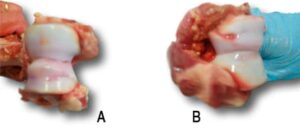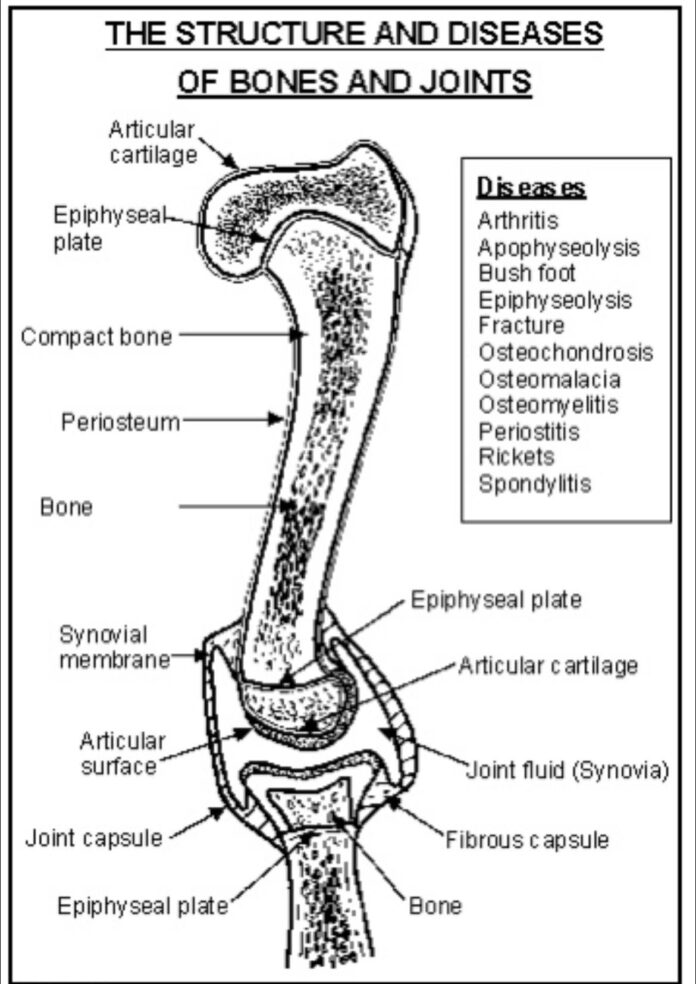Leg Weakness (Osteochondrosis) in pigs
Leg weakness affects growers, finishers, sows and boars with various causes being genetic, rapid growth, lack of exercise and a nutritional imbalance. The noticeable effects will be difficulty in rising or walking, swaying and misshapen limbs.
Causes
Osteochondrosis is a generalised skeletal disease which leads to leg weakness. The changes have been shown in piglets at a day old and may be congenital. Osteochondrosis becomes more obvious with age.
The cause appears to be a defect in the chondrocytes (cartilage cells) which do not mature normally. The formation prevents blood vessel formation and the formation of normal bone. It is also true to say that the growth rate and heredity factors appear to affect development. The changes lead to abnormal growth and change in the shape of bones and joints, including the vertebrae. Erosion of the articular cartilage and painful osteoarthritis of the joint development. Epiphysiolysis (The loosening or separation, either partial or complete, of an epiphysis – rounded end of a long bone – from the shaft of a bone) can result when the head of the femur is shed in rapidly growing animals.
Source of transmission
The condition is not transmissible from pig to pig in a group. It is deemed as hereditary. Common environmental factors such as nutrition, flooring, degree of exercise will compound the issue.
Clinical signs
Present in up to 80% of pigs, particularly heavy, rapidly growing in meaty breeds such as Dutch Landrace or Swedish Landrace, or Duroc kept on hard flooring. Clinical signs include shortening of the step, knock and buck knees and swaying of the forelimbs. In the hind limb the feet may be positioned too far forward, and pigs stand with their legs apart and show weakness at the pastern and swaying of the hindquarters. Changes increase with age, where you may witness hind limb lameness and pain at the hip but not necessarily at the stifle or hock. The affected leg is shorter than the unaffected one, but the thickness of the muscle mass makes identification difficult. Animals may be unable to rise, adopt a dog-sitting position and resent movement.

Osteochondrosis is a common cause of leg weakness and lameness in young breeding stock and may progress to arthrosis (degeneration of the joints) and deformation of affected bones completely by 6-9 months of age. Forelimb weakness is obvious in boars. Kyphosis (curvature of the spine) may also develop as the pigs attempt to adjust their gait on their affected limbs.
Clinical signs of bowed legs and swaying gait suggest the presence of osteochondrosis. Epiphysiolysis should be suspected where gilts are delivered lame or where they become lame suddenly at or around service. Osteochondrosis can be confirmed by radiography from 63 days of age. Confirmation at slaughter or post-mortem is more common.
A) no irregularity of the cartilage, and severe irregularity of the cartilage
Treatment and prevention
There is no treatment although lameness may resolve after moving to non-slip softer floors or deep bedding. The production effects resulting from lame boars and gilts can be overcome by use of artificial insemination.
The condition cannot be prevented completely, but its severity can be reduced. It has been suggested that the calcium and phosphorus levels of high nutrient density diets should be increased in order to supply adequate levels of these minerals in rapidly-growing pig breeds.
Exercise and space to roam around is beneficial for both breeding boars and gilts/sows. There is evidence that the condition may be under genetic control. It is much less common in large White than in Landrace pigs and genetic studies with Duroc boars suggest that it can be selected against. This selection may simply reduce the stress on joints provided by large hams or other features of conformation. In all cases where leg weakness is visible, the condition of the floors should be improved, non-slip surfaces and a good deep straw breeding or rubber matting which is soft underfoot.
DrParvinder Kaur Lubana
Assistant Director North Regional Disease Diagnostic Laboratory (NRDDL JALANDHAR,Punjab



